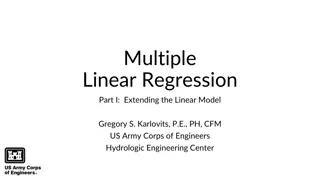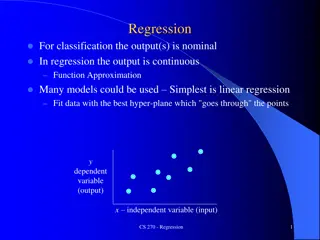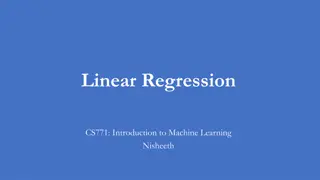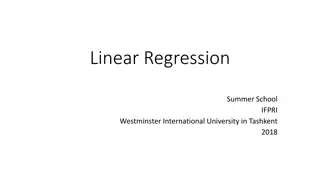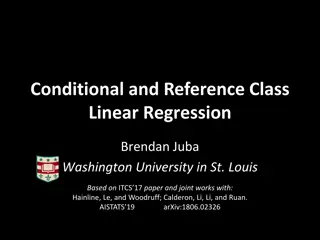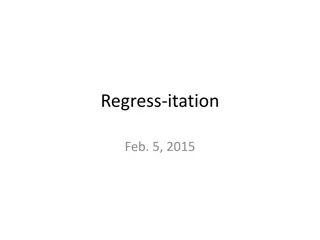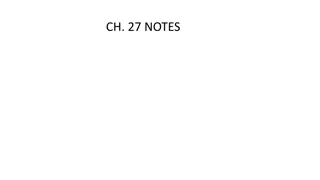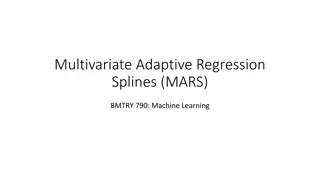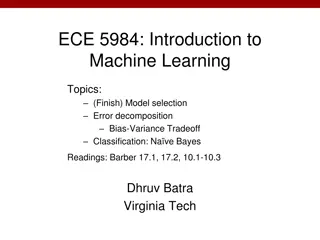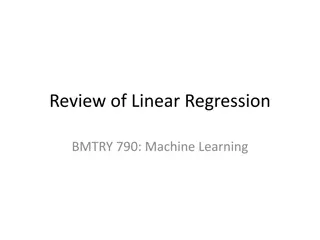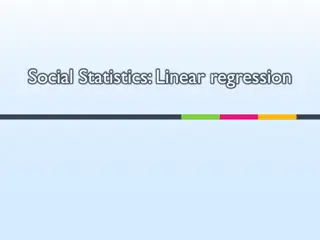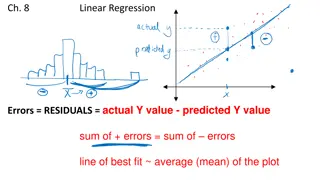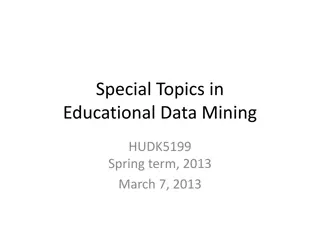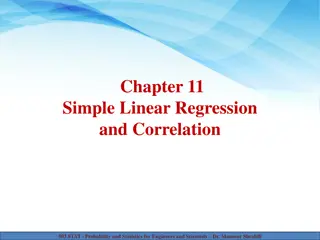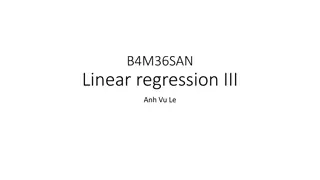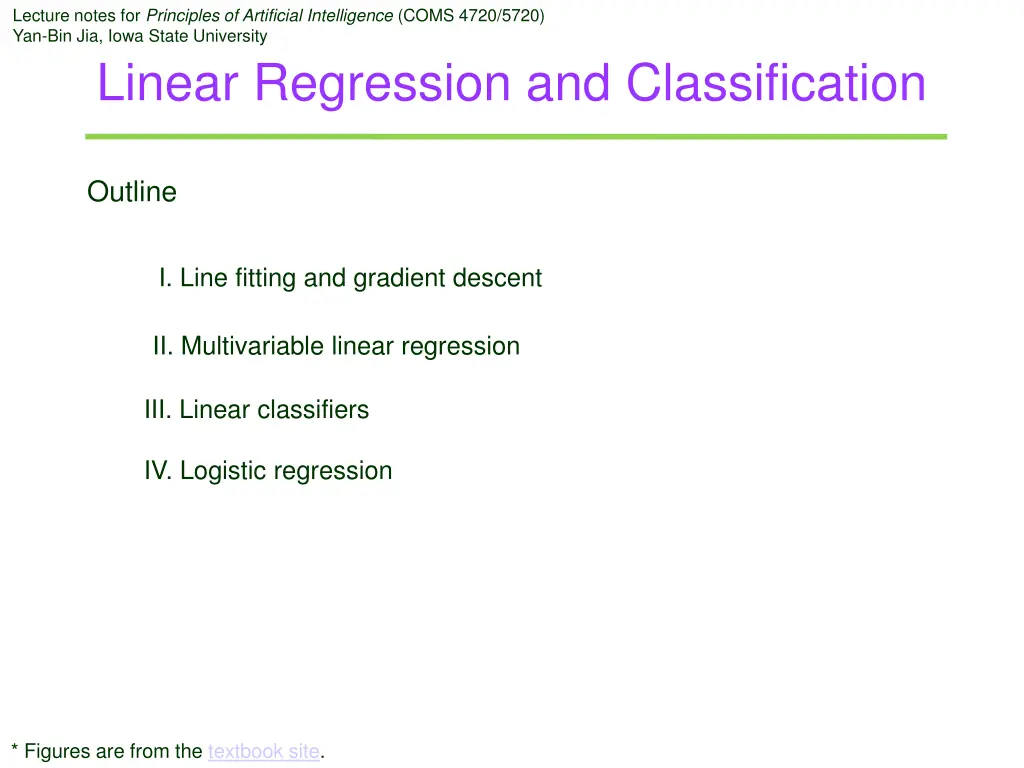
Linear Regression and Classification Overview
Explore the concepts of linear regression and classification in artificial intelligence, covering topics such as line fitting, gradient descent, multivariable regression, linear classifiers, and logistic regression. Understand the mathematical foundations and practical applications of these key techniques.
Download Presentation

Please find below an Image/Link to download the presentation.
The content on the website is provided AS IS for your information and personal use only. It may not be sold, licensed, or shared on other websites without obtaining consent from the author. If you encounter any issues during the download, it is possible that the publisher has removed the file from their server.
You are allowed to download the files provided on this website for personal or commercial use, subject to the condition that they are used lawfully. All files are the property of their respective owners.
The content on the website is provided AS IS for your information and personal use only. It may not be sold, licensed, or shared on other websites without obtaining consent from the author.
E N D
Presentation Transcript
Lecture notes for Principles of Artificial Intelligence (COMS 4720/5720) Yan-Bin Jia, Iowa State University Linear Regression and Classification Outline I. Line fitting and gradient descent II. Multivariable linear regression III. Linear classifiers IV. Logistic regression * Figures are from the textbook site.
I. Linear Regression Data points: ?1,?1, ?2,?2, , ??,?? inputs outputs Houses for sale in Berkeley, CA Hypothesis space: univariate linear functions. ?(?) ?1? + ?0 (?0,?1) Linear regression: Find the ? that best fits the data.
Line Fitting We find the weights (?0,?1) that minimizes the empirical loss. Use the squared-error loss ?2?, ? = ? ? 2, summed over all the points. ? Loss ? = ?2(??, ?(??)) ?=1 ? 2 = ?? ?(??) ?=1 ? 2 = ?? (?1??+ ?0) ?=1 ? = argmin Loss ? ?
Vanishing of Partial Derivatives At the minimizing ?, the gradient of Loss ? must vanish: ? = 0.232? + 246 ?Loss ??0 ,?Loss ??1 Loss ? = = 0 ? ?Loss ??0 ? 2= 0 = ??0 ?? (?1??+ ?0) ?=1 ? ?Loss ??1 ? 2= 0 = ??1 ?? (?1??+ ?0) Note: Linear regressing (LR) is not appropriate for fitting a line to data points geometrically when their x- and y-coordinates have the same physical units. The best-fitting line in LR does not minimize the sum of squares of distances of the data points to the line. Here, the distance in the ?-direction is used to approximate the point-line distance. Such approximation gets worse the larger the line s slope is, in which case fitting will also become sensitive to small changes in point locations. In addition, the model ?(?) ?1? + ?0 cannot represent a vertical line, hence a loss of generality. ?=1 ? ? ? ?1=? ?=1 ???? ?=1 ?? ?=1 ?? 2 ? 2 ?=1 ? ? ?=1 ?? ?? ? ? ?0=1 The best line fitting method, used in computer vision for extracting straight edges from an image, uses the general line equation ?? + ?? + ? = 0 subject to the constraint that ?2+ ?2= 1, applying the method of Lagrange multipliers. (See Section 3 of the COMS 4770/5770 notes on least-squares fitting). ?? ?1 ?? ? ?=1 ?=1 COMS 4770/5770 notes on least-squares fitting
Plot of the Loss Function ? 2 Loss ? = ?? (?1??+ ?0) ?=1 Convex function with no local minima.
Gradient Descent For a complex loss function, vanishing of its gradient often results in a system of nonlinear equations in ? that does not have a closed-form solution. Instead, the method of gradient descent is used: Start at a point ? in the weight space. Compute an estimate of the gradient of the loss function. Move a small amount in the direction of the negative gradient, i.e., the steepest downhill direction. Repeat until convergence on a point with (local) minimum loss. ? any point in the parameter space while not converged do for each ?? in ?do ?? ?? ? ? ?,? = cos2? + cos2?2 ? ???Loss(?) Gradient map step size or learning rate * Section 19.6.2 applies gradient descent to a quadratic loss function, which defeats the purpose since the gradient Loss ? is linear in ? whose values can be easily determined from solving the linear system Loss ? = 0. ** To see how gradient descent works, see Section 4 of the COMS 4770/5770 notes on nonlinear optimization.
Multivariable Linear Regression An example is represented by an ?-vector ??= (??,1, ,??,?). Hypothesis space: ? ?? = ?0+ ?1?1+ + ????= ?0+ ???? ?=1 For convenience, we extend ? by adding ?0= 1 such that ? = (1,?1, ,??). ?? = ? ? Best weight vector: ? = argmin ?2(??,? ??) ? ?
Optimal Weights Write ? as a column vector, i.e., ? = ?0,?1, ,?? Vector of ? outputs: ? = ?1,?2, ,?? ?. ?. ?1 ?? Data matrix (? ?): ? = Predicted outputs: ? = ?? Loss over all the training data: ? ? = ? ? 2= ?? ? 2 0 = ? ? = ?? ???? ? ???? ??? = 0 ? almost always has full rank since ? ? 1??? ? = ? = ??? pseudoinverse of ?
Regularization Commonly applied on multivariable linear function to avoid overfitting. Cost( ?)= EmpLoss ? + ?Complexity( ?) where ? |??|? Complexity ? = ??? = ?=1 ?1 (with ? = 1) regularization tends to produce a sparse model (in which many weights are set to zero) because it takes the ?0,?1, ,?? axes seriously. ?2 (with ? = 2) regularization takes the dimension axes arbitrarily.
III. Linear Classifiers earthquakes nuclear explosions Seismic data for earthquakes and nuclear explosions: ?1 and ?2 respectively refer to body and surface wave magnitudes computed from the seismic signal. Same domain with more data points. Task Learn a hypothesis that will take new (?1,?2) points and return 0 for earthquakes and 1 for explosions.
Linear Separator A decision boundary is a line that separates two classes. A linear separator is a linear decision boundary. e.g., 4.9 + 1.7?1 ?2= 0 ? = ?0,?1, ,?? ? = ?0,?1, ,?? ? = 1 Classification hypothesis: Not linearly separable! 1 if ?? 0 ?(?) = 0 if ?? < 0
Learning Rule 1 if ?? 0 Gradient ? either vanishes or is undefined. ?(?) = 0 if ?? < 0 Use the perceptron learning rule (essentially borrowed from gradient descent): ?? ??+ ?(?? ?(??))??,? on a single example (??,?) ??= ?(??). The output is correct, so no change of weights. ??= 1 but ??? = 0. ??is increased if ??,?> 0 and decreased if ??,?< 0. In both situations, ?? increases with the intention to output 1. ??= 0 but ??? = 1. ??is decreased if ??,?> 0 and increased if ??,?< 0. In both situations, ?? decreases with the intention to output 0.
Training Curves for Perceptron Learning The learning rule is applied one example at a time. A training curve measures the classifier performance on a fixed training set as learning proceeds one example at a time on the same set. ? = 1 657 steps before convergence 63 examples, each used 10 times on average
Training Curves (contd) Data not linearly separable. Fails to converge after 10,000 steps. Let ? decay as ?(1/?) where ? = # iterations. ?? ??+ ?(?? ?(??))??,? e.g., ? ? = 1000/(1000 + ?)
IV. Logistic Function Current hypothesis function is not continuous, let alone differentiable. This makes learning with the perceptron rule very unpredictable. It would be better if some examples could be classified as unclear borderline cases. Use a continuous, differential function to soften the threshold Hypothesis function: Logistic function: 1 1 Logistics ? = ?(?) = ?? = Logistics ?? = 1+? ? 1 + ? ?? 1 if ?? 0 ?(?) = 0 if ?? < 0
Logistic Regression Fit the model ?? = Logistics ?? to minimize loss on a data set. Still apply gradient descent. 1 Logistics ? = ?(?) = 1 + ? ? ? ? 2 Loss ? = ? ?? ??? ??? = 2(? ?? ) ? (??) ?? ? ?? = ?(??)(1 ? ?? ) = ?? (1 ?? ) = 2(? ?? ) ?? (1 ?? ) ?? Weight update: ?? ??+ ?(? ?? ) ?? (1 ?? ) ??
Improvements on Training Results ? ? = 1000/(1000 + ?) Logistic regression converges far more quickly and reliably. ? ? = 1000/(1000 + ?) ? = 1 ? = 1

